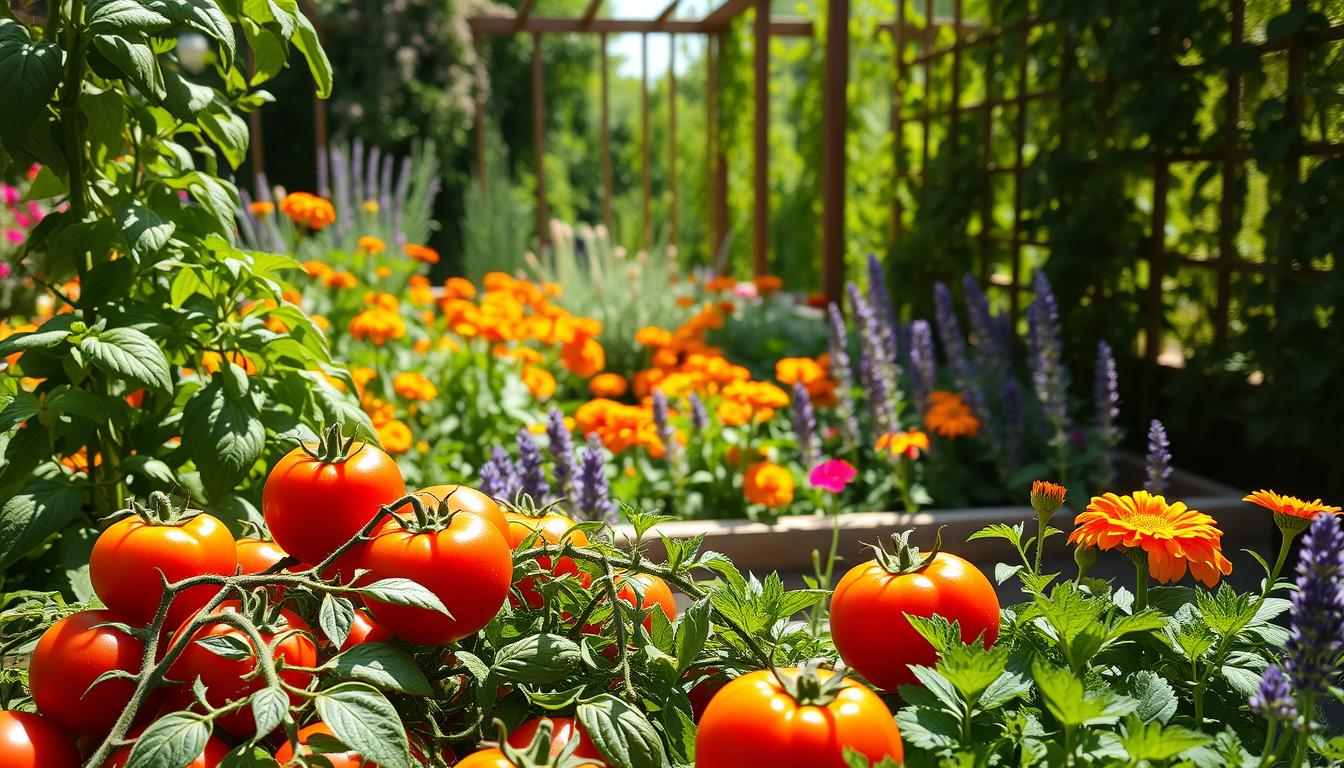There’s something truly magical about strolling through your garden and seeing vibrant tomatoes nestled amidst a bed of complementary plants. The joy of harvesting those juicy fruits, knowing that you’ve created a thriving ecosystem, is a feeling every gardener experiences. But understanding how to nurture that ecosystem starts with one key principle: tomato companion planting. Imagine not only growing beautiful tomatoes but also discovering which perfect tomato companions can enhance their growth, flavor, and vitality. Together, let’s explore what grows well with tomatoes and how these vegetable garden companions can elevate your gardening experience.
Key Takeaways
- Tomato companion planting can boost the health and flavor of your crop.
- Choosing ideal plant partners is crucial for a productive garden.
- Some plants naturally repel pests, offering organic protection for your tomatoes.
- Certain herbs and flowers not only beautify your garden but also aid in tomato growth.
- Proper spacing and seasonal timing enhance the benefits of companion planting.
Understanding Tomato Companion Planting
Growing tomatoes alongside specific plants can significantly enhance your gardening experience. Understanding tomato companion planting allows you to create a thriving environment for your tomatoes while taking advantage of the benefits of companion planting.
Benefits of Companion Planting
Implementing companion planting strategies can lead to numerous advantages. The most notable benefits include:
- Pest Deterrence: Certain plants repel pests that might damage your tomatoes.
- Improved Pollination: Some companions can attract beneficial pollinators to your garden.
- Nutrient Enrichment: Plants can enhance the nutrient profile of the soil, promoting healthier growth.
- Growth Support: Some plants improve the overall growth conditions for tomatoes.
How Plants Help Each Other
Various plants work together in ways that enhance growth and productivity. For instance, beneficial insects attracted to specific flowers may help with pollination or pest management, while some companion plants might fix nitrogen in the soil, benefiting nearby tomatoes. Understanding tomato companion planting involves appreciating these interdependencies.
What to Avoid Planting with Tomatoes
While many plants will thrive alongside tomatoes, some are better left out of the garden. Key plants to avoid include:
- Corn: It can attract common pests, such as the corn earworm, that may also target tomatoes.
- Brassicas: Plants like cabbage and broccoli compete for nutrients and can disturb tomato growth.
- Potatoes: Growing potatoes near tomatoes can increase the risk of diseases like blight.
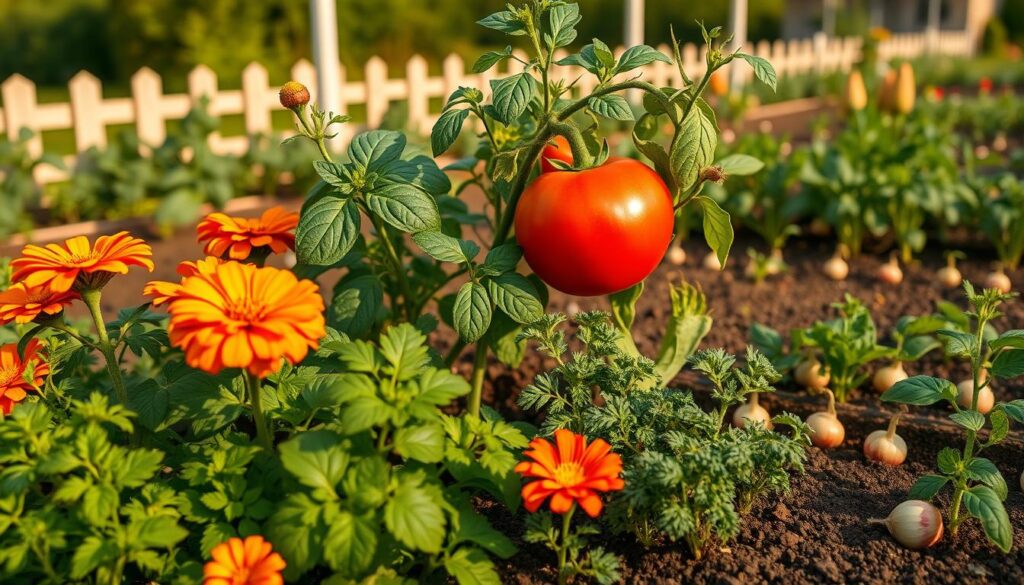
Herbs That Thrive with Tomatoes
In your quest to create a successful garden, understanding the herbs that thrive with tomatoes plays a crucial role. Selecting the right companion plants for tomatoes not only enhances flavor but can also boost growth and deter pests. Three standout choices include basil, oregano, and parsley, each offering unique benefits and flourishing alongside tomato plants.
Basil: The Classic Companion
Basil is often considered one of the best plants to grow with tomatoes. This aromatic herb not only elevates the flavor of your tomatoes but also possesses natural pest-repelling properties. The scent of basil keeps harmful insects at bay, making your tomato plants healthier and more productive.
Oregano: For Flavor and Pest Control
Oregano stands out as another excellent companion plant for tomatoes. It attracts beneficial pollinators while providing sensational flavor to various dishes. The robust nature of oregano enables it to grow well in the garden, helping to safeguard your tomato plants from pest pressure.
Parsley: A Nutrient Booster
Parsley is a lesser-known gem among herbs that thrive with tomatoes. This versatile herb not only enhances culinary dishes but also serves as a protector against aphids. By attracting hoverflies, parsley ensures that your tomato plants remain safe from these common pests, making it an ideal addition to your garden.
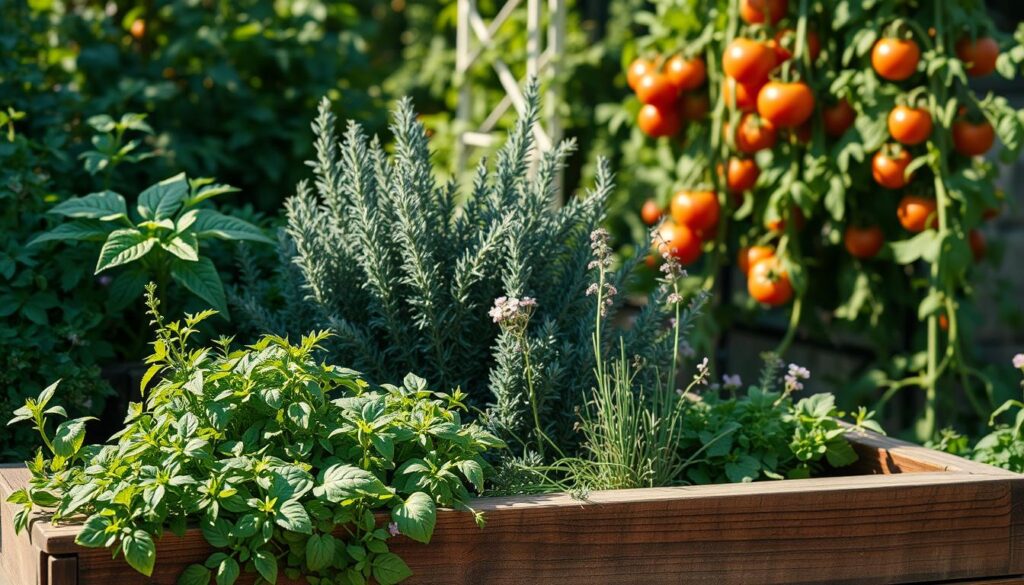
| Herb | Benefits | Growing Conditions |
|---|---|---|
| Basil | Enhances flavor, repels pests | Warm, well-drained soil, full sun |
| Oregano | Attracts pollinators, flavors dishes | Well-drained soil, moderate sunlight |
| Parsley | Attracts hoverflies, protects tomatoes | Rich, moist soil, partial sun |
Vegetables That Enjoy Tomato Company
When planting tomatoes, consider incorporating other vegetables that enjoy tomato company. Peppers, carrots, and onions serve as excellent tomato plant companions, enhancing both flavor and garden health.
Peppers: Spicy Support
Integrating peppers into your tomato garden provides a satisfying spicy kick to various dishes. Both plants belong to the nightshade family, so exercise caution with spacing to prevent diseases. Nevertheless, they coexist well and contribute to a vibrant garden.
Carrots: Rooting for Tomatoes
Carrots not only thrive alongside tomatoes but also improve soil aeration. As tomatoes grow tall, they offer shading to carrots, allowing them to flourish without excessive sunlight. This mutual benefit makes planting tomatoes with other vegetables like carrots a smart choice.
Onions: Flavor Allies
Onions stand out as reliable flavor allies that deter pests with their potent odor. This characteristic helps in safeguarding tomatoes from harmful insects. Combining onions with tomatoes can lead to a healthier and more productive garden, making them essential tomato plant companions.
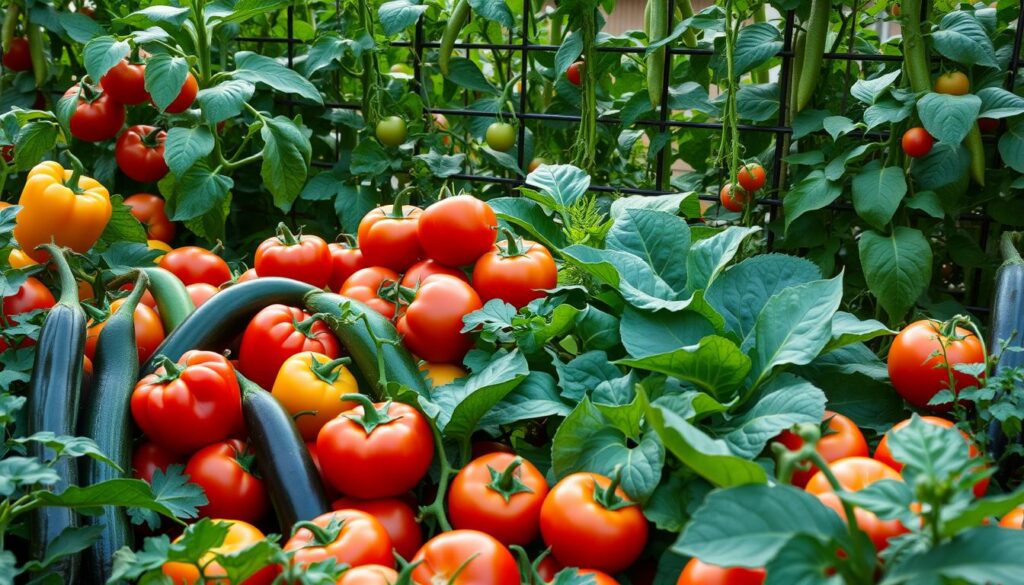
Flowers that Benefit Tomatoes
Incorporating flowers into your garden can enhance both the aesthetics and the health of your tomato plants. Certain flowers not only beautify your space but also play significant roles in supporting pest control for tomato plants. By utilizing companion planting for tomatoes with specific flowers, you can create a healthier, more productive garden.
Marigolds: Natural Pest Repellent
Marigolds are renowned for their ability to deter unwanted pests. These vibrant blooms emit compounds that repel harmful insects like nematodes and aphids, making them perfect companions for your tomato plants. By planting marigolds nearby, you can significantly reduce the incidence of pest problems while boosting your garden’s overall health.
Nasturtiums: Attracting Beneficial Insects
Nasturtiums serve a dual purpose in your tomato garden. Not only do they attract beneficial insects such as ladybugs and hoverflies, but they also lure aphids away from tomatoes, acting as a trap crop. This strategy optimizes the ecosystem, ensuring that your tomatoes thrive while maintaining a natural balance in pest control.

Legumes to Enhance Soil Health
Incorporating legumes in your garden serves a dual purpose, assisting both your tomato plants and the overall soil health. These nitrogen fixing plants play a crucial role in enriching the earth, making them essential companions for heavy feeders like tomatoes. Utilizing companion planting to improve soil can significantly boost your gardening efforts.
Beans: Nitrogen Fixers
Beans are among the most effective legumes to enhance soil health. As nitrogen fixing plants, they can convert atmospheric nitrogen into a form that is accessible for your garden soil. Placing beans alongside tomatoes not only nourishes the soil but encourages a thriving environment where your tomatoes can flourish.
Peas: Boosting Your Garden’s Fertility
Peas contribute similarly to beans by fixing nitrogen and enhancing soil fertility. These legumes can be planted early in the spring, allowing for a steady nitrogen supply as your tomatoes begin to grow. Their deep root systems also help improve soil structure, creating an optimal home for your plants.
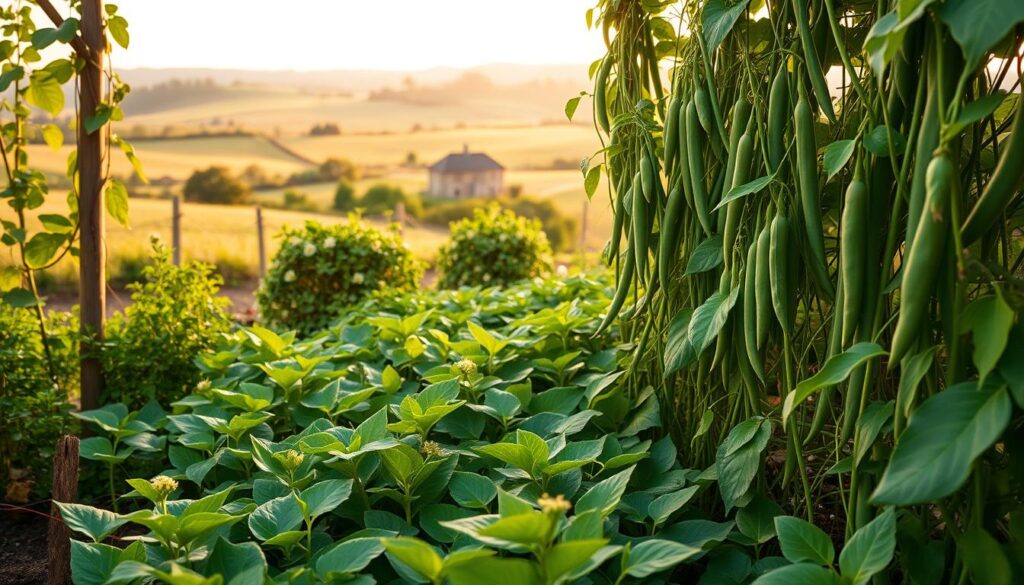
| Legume Type | Nitrogen Fixation | Benefits for Tomatoes |
|---|---|---|
| Beans | High | Improves soil nutrients and structure |
| Peas | Moderate | Enhances soil fertility and moisture retention |
Companion Planting for Pest Control
Using companion planting for pest control can be a game-changer for anyone looking to protect their tomatoes. By strategically selecting plants that deter pests, you not only enhance your tomato plants’ health but also create a more vibrant garden ecosystem. Let’s explore how certain companion plants can keep unwanted pests at bay.
How Companion Plants Deter Pests
Companion plants play a vital role in protecting tomatoes from pests. Some plants that deter pests release scents or chemicals that repel harmful insects. For instance, the aroma of garlic can serve as a natural insect repellent, making it a worthy addition to your garden. Other plants work differently; they may attract beneficial insects that feed on common tomato pests, creating a balanced environment.
Specific Companion Plants for Pest Management
Here are some effective companion plants for tomatoes that help in pest management:
- Marigolds: Known for their bright flowers, marigolds repel nematodes and aphids with their scent.
- Garlic: This potent plant releases sulfur compounds that deter various insects.
- Dill: Its feathery foliage attracts ladybugs and lacewings, both of which consume aphids.
- Thyme: This aromatic herb repels cabbage worms and is beneficial to soil health.
Incorporating these plants into your garden will not only provide pest control benefits but will also enhance the beauty and biodiversity of your space.
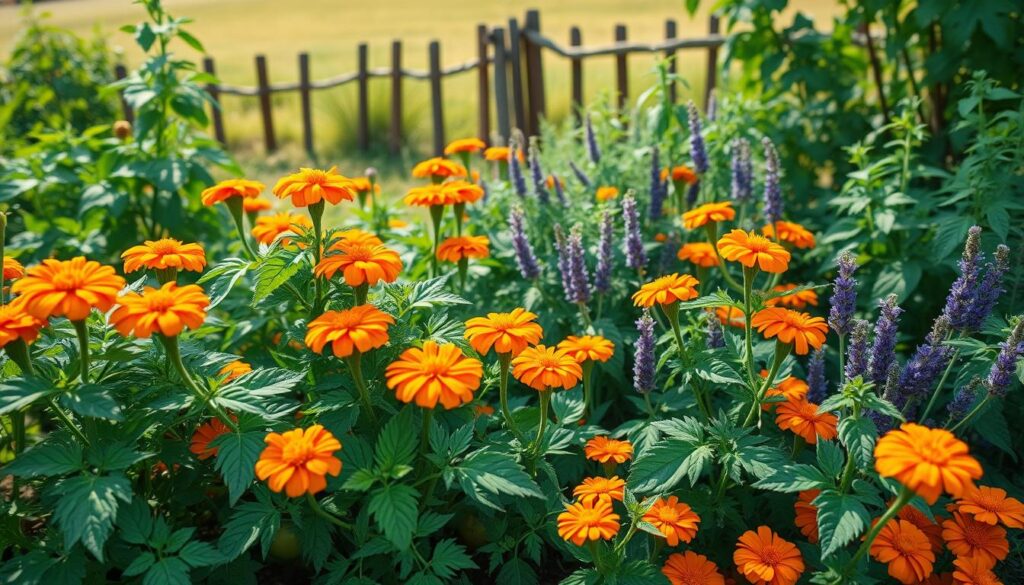
Companion Plants for Enhanced Growth
Creating a thriving tomato garden involves selecting the right companion plants for enhanced growth. These plants can significantly impact the growth rate of your tomatoes. For instance, legumes like beans and peas enrich the soil with nitrogen, a crucial nutrient that aids in the development of tomatoes. Additionally, herbs such as basil and parsley can improve water retention around the roots, creating a conducive environment for accelerated growth. Understanding the role these plants play will help you maximize your garden’s potential.
What Plants Promote Faster Growth?
Incorporating certain plants that support faster growth can make a remarkable difference in your tomato garden. Here are a few notable companions:
- Legumes: Beans and peas are excellent nitrogen fixers that will enrich the soil naturally.
- Herbs: Basil and parsley not only repel pests but also improve moisture retention, benefiting tomato plants.
- Marigolds: These flowers attract beneficial insects and enhance the soil’s health, supporting tomato growth.
The Role of Fungal Networks
Fungal networks in planting, especially mycorrhizae, play a crucial role in enhancing your tomato plants’ health. These beneficial fungi connect with plant roots, improving nutrient and water absorption significantly. When tomatoes are paired with companion plants with established mycorrhizal connections, the overall growth and vitality of the tomato plants increase. By fostering these partnerships, you can ensure your tomatoes thrive and produce a bountiful harvest.
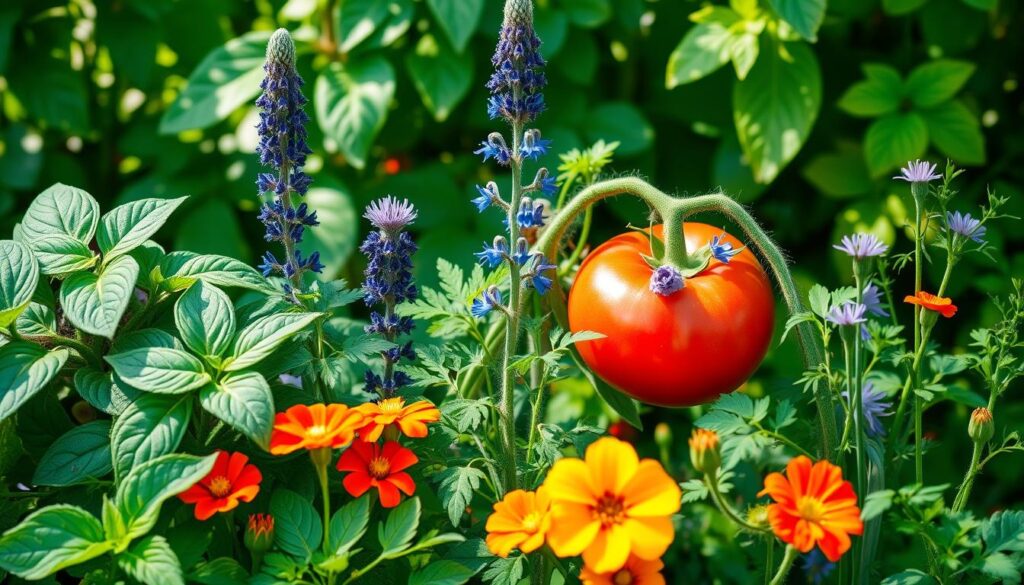
Importance of Proper Spacing
Understanding the importance of proper spacing in your garden can greatly impact the success of your plants. Tight companion planting spacing might seem appealing, but it often leads to competition among plants for vital resources such as sunlight, nutrients, and moisture. Each type of plant requires room to thrive, and adjusting your layout based on the needs of individual species will create a healthier growing environment.
How Close is Too Close?
When considering plant placements, you should be aware of how close is too close. Many gardeners underestimate the space requirements of their plants. For example, tomatoes need ample room to grow, as overcrowding leads to increased humidity, which can foster disease. Assess the recommended spacing for each plant type to avoid potential health issues in your garden.
Benefits of Adequate Spacing
Embracing the benefits of spacing in gardening allows for better air circulation, sunlight penetration, and overall plant health. Adequate spacing not only helps prevent overcrowding but also enhances the growth of companion plants. By ensuring each plant has its space, you create opportunities for organic interactions, leading to an enriched garden ecosystem. Proper spacing is a key element in efficient companion planting, making it essential for every gardener.
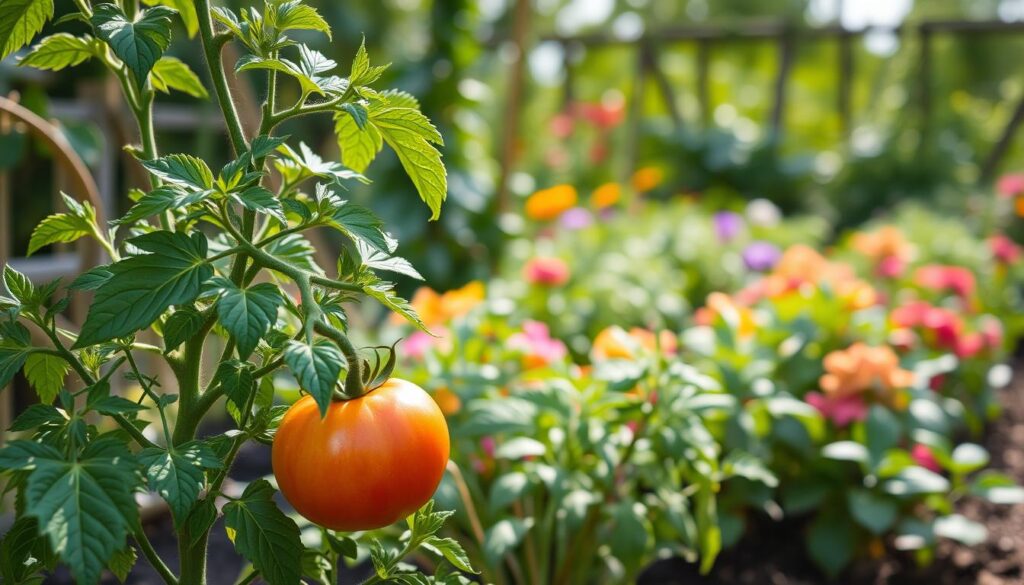
Seasonal Considerations
Understanding the right timing plays a pivotal role in the success of companion planting. You should consider seasonal considerations for planting to effectively manage your crops. By aligning your planting schedule with seasonal patterns, you can optimize growth and maximize the benefits of companion plants.
Best Time to Plant Companion Plants
Knowing the best time for companion plants ensures they thrive alongside your tomatoes. Generally, it is advantageous to plant companion species early in the season. As soon as the risk of frost has passed, you can introduce plants like basil and marigolds to give a head start in pest control. Aim for the weeks just before or right at your local planting season’s start to establish a strong foundation for growth.
Rotational Planting Tips
Implementing rotational planting strategies can safeguard your soil health and enhance crop yields. By rotating your tomato planting locations each season, you reduce the risk of soil-borne diseases and nutrient depletion. Keep a record of your plots and which plants you have grown in each to optimize your use of nutrients and space in subsequent growth cycles.
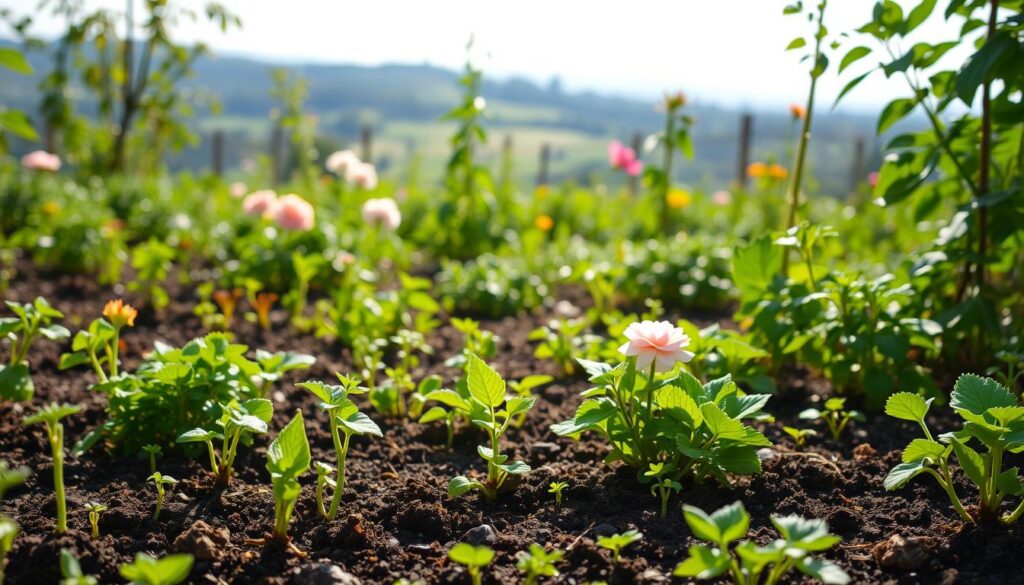
Nutrient Requirements of Tomato Companions
Understanding the nutrient requirements for tomato companions can significantly impact the health and productivity of your garden. Each companion plant thrives under different soil needs for planting, making it essential to consider how these plants interact with tomatoes. Proper nutrient matching allows for a more efficient uptake, enhancing growth and flavor.
Understanding Soil Needs
The foundation of a successful tomato garden lies in its soil composition. Different plants have varying soil needs for planting, including pH levels and organic matter content. For example, legumes like beans can improve soil fertility by fixing nitrogen, while leafy greens often require higher levels of potassium. Assessing these soil needs enables you to create a balanced environment, fostering healthy growth among tomato companions.
Matching Nutrients with Companion Plants
Matching nutrients in companion planting is vital for achieving harmonious plant relationships. Certain combinations allow plants to share available nutrients efficiently. For instance, tomatoes benefit from the companionship of basil, which not only holds similar nutrient requirements but also enhances tomato flavor. Ensuring that the nutrient profiles of companion plants complement each other leads to a more vibrant and productive garden.
| Companion Plant | Nutrient Requirements | Soil Needs |
|---|---|---|
| Basil | High in nitrogen and potassium | Well-draining, rich in organic matter |
| Beans | High in nitrogen | Loamy, well-aerated soil |
| Onions | Moderate nutrients including potassium | Well-drained, slightly acidic |
| Marigolds | Low nutritional needs | Mainly well-draining soil |
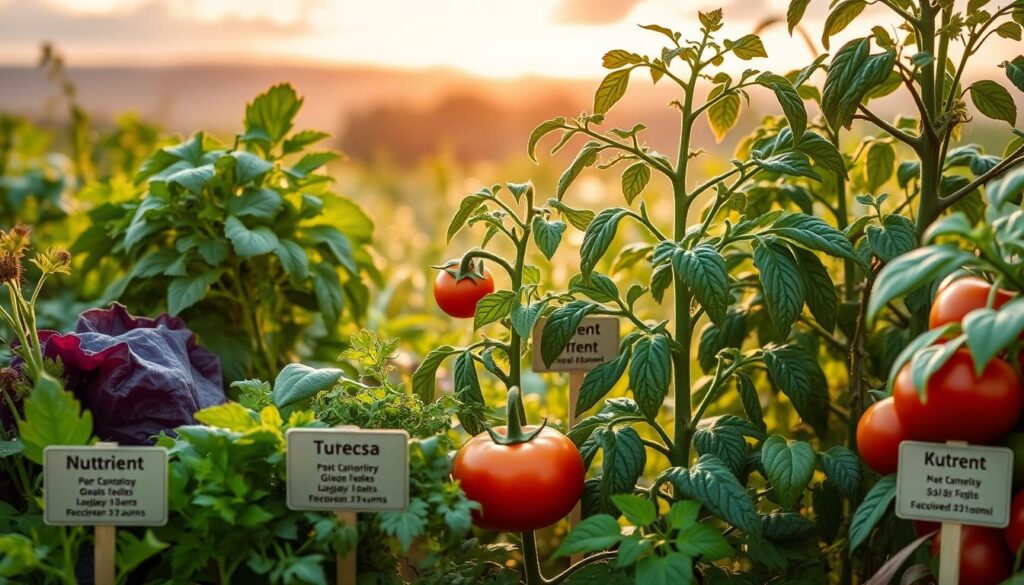
Common Companion Planting Mistakes
As you embark on the journey of companion planting, be mindful of the common companion planting mistakes that many gardeners encounter. Awareness of these pitfalls can enhance your tomato-growing experience and lead to a healthier, more productive garden.
Mistakes to Avoid with Tomatoes
One of the biggest mistakes to avoid with tomatoes includes planting them too close to incompatible species. This can result in competition for nutrients, light, and space. Another frequent error is neglecting to consider soil needs. Different plants have various nutrient requirements, and failing to match them can lead to subpar growth. Overcrowding is another issue. It prevents proper air circulation, making plants more susceptible to diseases and pests.
How to Correct Common Errors
Correcting planting errors requires careful observation and a willingness to adapt. Start by assessing the layout of your garden. Ensure sufficient spacing between tomato plants and their companions to encourage healthy growth. When choosing companion plants, prioritize those that can share similar soil and water requirements. Regularly monitor your plants and adjust their arrangement as needed to minimize competition.
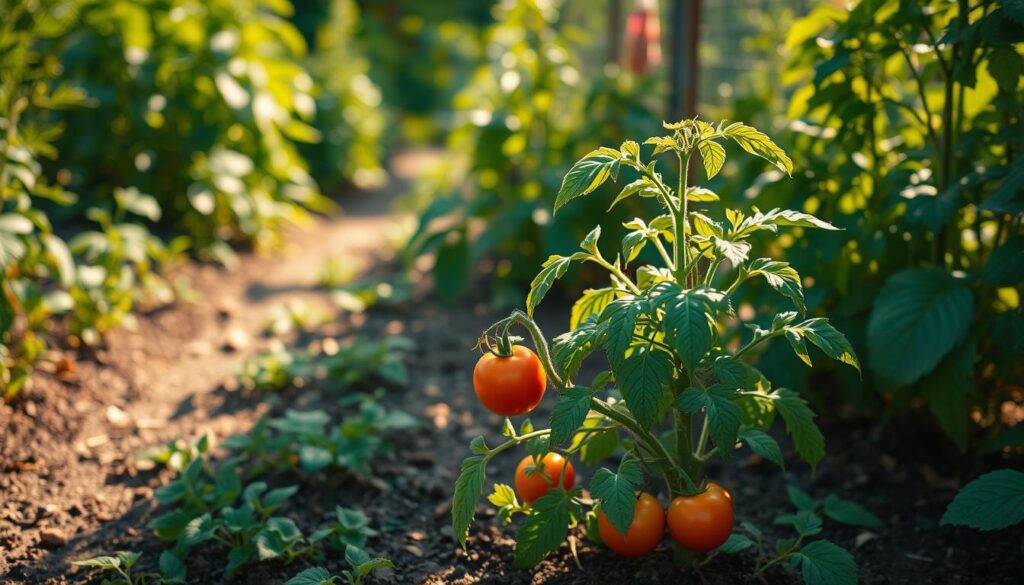
Organic Practices for Companion Planting
Embracing organic practices in companion planting creates a thriving ecosystem in your garden. The first step involves choosing organic seeds for gardens, which reduces the risk of introducing harmful chemicals into the soil. Using high-quality, organic seeds ensures that your plants grow robust and resilient. Following this, you can implement various natural pest control methods to manage any potential threats. These strategies not only protect your plants but also contribute to a healthier garden environment.
Choosing Organic Seeds
When it comes to successful gardening, choosing organic seeds for gardens stands out as a vital part of the process. Organic seeds are cultivated without synthetic pesticides or fertilizers. This choice leads to plants that are more in tune with their natural environments. Look for reputable sources that offer a variety of organic seeds to match your garden’s needs and climate. Starting with healthy seeds lays a strong foundation for your plants’ growth and resilience.
Natural Pest Control Methods
Implementing natural pest control methods enhances your garden’s health. Techniques include using plant-derived repellents, companion planting, and introducing beneficial insects, such as ladybugs and lacewings. These methods work synergistically to maintain plant health while minimizing damage from pests. Utilizing these strategies aligns with the principles of sustainable gardening, ensuring that your efforts contribute positively to the environment.
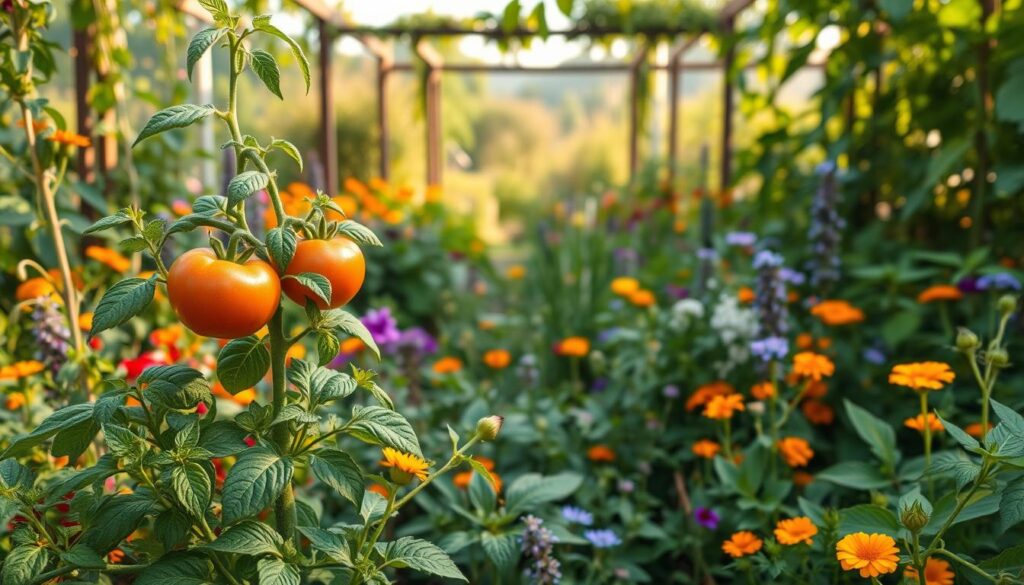
Incorporating natural methods provides an effective way to maintain garden health without relying on synthetic interventions. This holistic approach not only benefits your tomatoes but also creates a more vibrant ecosystem overall.
Growing in Containers
Container gardening offers a practical solution for those eager to enjoy fresh tomatoes, even in limited space. By adopting techniques for growing tomatoes in containers, you create an ideal environment for planting companions that enhance flavor and growth. Understanding how to arrange your pots will streamline the process of companion planting in pots, ultimately leading to bountiful harvests.
Can You Companion Plant in Pots?
Yes, companion planting in pots is not only possible but highly beneficial. Different plants can thrive together in a confined space, provided they share similar needs for sunlight and water. Selecting the right companions will enrich the growing conditions, reduce pests, and improve soil nutrients. You can easily combine herbs like basil with your tomatoes or pair them with flowers like marigolds to deter pests.
Best Container Options for Tomatoes
Choosing the best container plants for tomatoes involves selecting pots that allow for good drainage and sufficient size for growth. Consider these options:
- 5-gallon buckets: Ideal for single tomato plants.
- Fabric pots: Provide excellent drainage and aeration.
- Self-watering containers: Maintain consistent moisture levels.
Experimenting with these container options helps enhance your success when growing tomatoes in containers and taking full advantage of companion planting strategies.
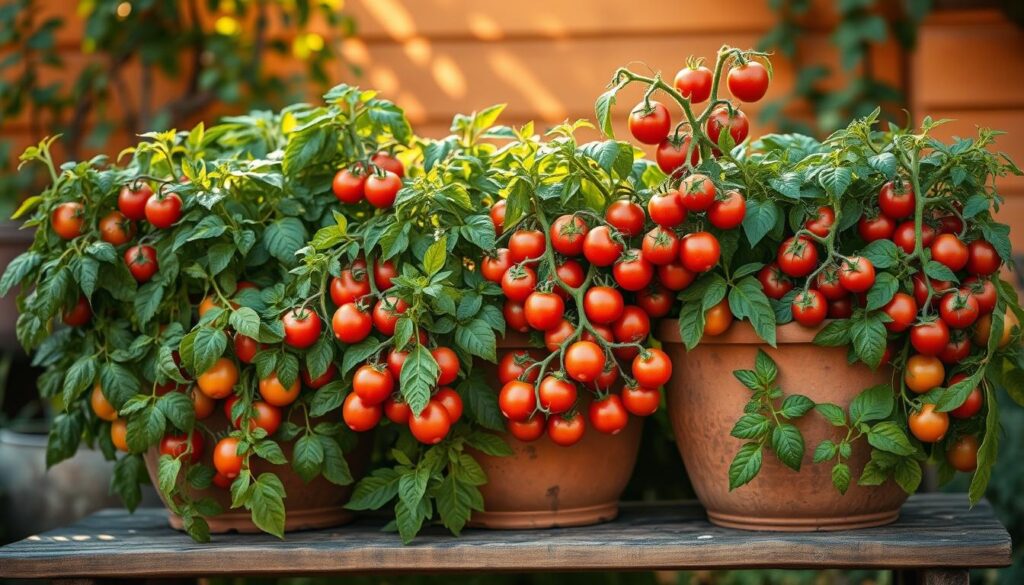
Companion Planting Resources
Accessing reliable companion planting resources can greatly enhance your gardening journey. A wealth of gardening books and guides is available to provide valuable information on choosing the right companion plants. Engaging with online communities for gardeners can also foster knowledge-sharing, allowing you to connect with others who share your passion for successful gardening.
Books and Guides for Further Reading
Many informative gardening books and guides focus on companion planting specifics. Consider these popular titles:
- The Vegetable Gardener’s Bible by Ed Smith – A comprehensive resource on various gardening techniques, with emphasis on companion planting.
- Companion Planting for Beginners by John Williams – A user-friendly guide dedicated entirely to the ins and outs of companion plants.
- Carrots Love Tomatoes by Louise Riotte – An insightful book explaining the symbiotic relationships between various plants.
Online Communities and Forums
Participating in online communities for gardeners can be immensely helpful. Here are some popular platforms to consider:
- Reddit – r/gardening – A dynamic forum where you can find discussions and advice on companion planting.
- GardenWeb Forums – A supportive environment where gardeners exchange tips and experiences related to various planting techniques.
- Facebook Gardening Groups – Join specific groups that focus on companion planting and share your own gardening queries.

Conclusion: A Thriving Tomato Garden
Creating a thriving tomato garden begins with the understanding of how companion planting can enhance your garden’s performance. By choosing the right plants to grow alongside your tomatoes, you can experience increased growth, better pest management, and even improved flavor profiles. Take the time to explore the various benefits of companion planting, as it’s clear that these relationships foster a more vibrant and productive gardening experience.
Now is the perfect opportunity to start experimenting with your garden! Don’t be afraid to try different plant combinations and witness their interactions firsthand. Each season offers a chance to learn something new, and by observing what works best in your unique environment, you set yourself up for future success. Embrace the process, and watch your tomato garden flourish year after year.
